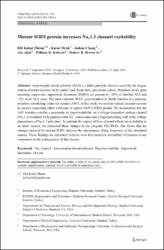| dc.contributor.author | Kubat Öktem, Elif | |
| dc.contributor.author | Mruk, Karen | |
| dc.contributor.author | Chang, Joshua | |
| dc.contributor.author | Akın, Ata | |
| dc.contributor.author | Kobertz, William R. | |
| dc.contributor.author | Brown, Robert H., Jr. | |
| dc.date.accessioned | 10.07.201910:49:13 | |
| dc.date.accessioned | 2019-07-10T19:57:26Z | |
| dc.date.available | 10.07.201910:49:13 | |
| dc.date.available | 2019-07-10T19:57:26Z | |
| dc.date.issued | 2016 | en_US |
| dc.identifier.citation | Kubat Öktem, E., Mruk, K., Chang, J., Akın, A., Kobertz, W. R. ve Brown, Robert H., Jr. (2016). Mutant SOD1 protein increases Na(v)1.3 channel excitability. Journal of Biological Physics, 42(3), 351-370. https://dx.doi.org/10.1007/s10867-016-9411-x | en_US |
| dc.identifier.issn | 0092-0606 | |
| dc.identifier.issn | 1573-0689 | |
| dc.identifier.uri | https://dx.doi.org/10.1007/s10867-016-9411-x | |
| dc.identifier.uri | https://hdl.handle.net/20.500.12511/2974 | |
| dc.description | WOS: 000379922500004 | en_US |
| dc.description | PubMed ID: 27072680 | en_US |
| dc.description.abstract | Amyotrophic lateral sclerosis (ALS) is a lethal paralytic disease caused by the degeneration of motor neurons in the spinal cord, brain stem, and motor cortex. Mutations in the gene encoding copper/zinc superoxide dismutase (SOD1) are present in similar to 20% of familial ALS and similar to 2% of all ALS cases. The most common SOD1 gene mutation in North America is a missense mutation substituting valine for alanine (A4V). In this study, we analyze sodium channel currents in oocytes expressing either wild-type or mutant (A4V) SOD1 protein. We demonstrate that the A4V mutation confers a propensity to hyperexcitability on a voltage-dependent sodium channel (Na(v)1.3) mediated by heightened total Na+ conductance and a hyperpolarizing shift in the voltage dependence of Na(v)1.3 activation. To estimate the impact of these channel effects on excitability in an intact neuron, we simulated these changes in the program NEURON; this shows that the changes induced by mutant SOD1 increase the spontaneous firing frequency of the simulated neuron. These findings are consistent with the view that excessive excitability of neurons is one component in the pathogenesis of this disease. | en_US |
| dc.description.sponsorship | Angel Fund; ALS Therapy; Project ALS; P2ALS; Pierre L. De Bourgknecht ALS Research Fund; National Institute of Neurological Disorders and Stroke (NINDS) [1RC2NS070342-01, 1RC1NS068391-01, R01NS050557-05, R01NS065847-01A1] | en_US |
| dc.description.sponsorship | This study was supported by the Angel Fund, the ALS Therapy, Project ALS, P2ALS, the Pierre L. De Bourgknecht ALS Research Fund, and the National Institute of Neurological Disorders and Stroke (NINDS) awards 1RC2NS070342-01, 1RC1NS068391-01, R01NS050557-05, and R01NS065847-01A1. We thank David Paydarfar for comments on the manuscript, Daryl Bosco for providing purified WT and mutant (A4V) human SOD1 protein, and Nick Wightman for assistance with Western immunoblotting. | en_US |
| dc.language.iso | eng | en_US |
| dc.publisher | Springer | en_US |
| dc.rights | info:eu-repo/semantics/openAccess | en_US |
| dc.subject | Na-v Channel | en_US |
| dc.subject | Amyotrophic Lateral Sclerosis | en_US |
| dc.subject | Hyperexcitability | en_US |
| dc.subject | Superoxide Dismutase | en_US |
| dc.subject | Oocyte | en_US |
| dc.title | Mutant SOD1 protein increases Na(v)1.3 channel excitability | en_US |
| dc.type | article | en_US |
| dc.relation.ispartof | Journal of Biological Physics | en_US |
| dc.department | İstanbul Medipol Üniversitesi, Rektörlük, Rejeneratif ve Restoratif Tıp Araştırmaları Merkezi (REMER) | en_US |
| dc.identifier.volume | 42 | en_US |
| dc.identifier.issue | 3 | en_US |
| dc.identifier.startpage | 351 | en_US |
| dc.identifier.endpage | 370 | en_US |
| dc.relation.publicationcategory | Makale - Uluslararası Hakemli Dergi - Kurum Öğretim Elemanı | en_US |
| dc.identifier.doi | 10.1007/s10867-016-9411-x | en_US |
| dc.identifier.wosquality | Q4 | en_US |
| dc.identifier.scopusquality | Q2 | en_US |


















